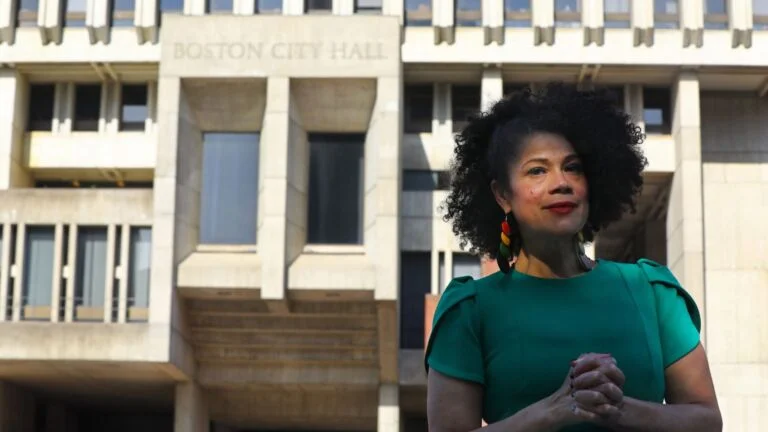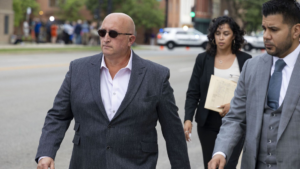Two Boston city councilors have introduced an ordinance that would create a commission to study how Boston might implement reparations.
The killing of Black men and women by police has impacted communities across the country over the last several years, but the recent violence is only the latest entry in a long history of cities treating their Black and brown citizens unequally.
From red-lining to building dirty power plants and factories near Black neighborhoods, the impacts of institutional racism have been well-documented.
As cities try to mend the harm and seek justice for victims, one idea being proposed is issuing “reparations” to Black citizens.
These cities are hoping to find effective ways of mitigating hundreds of years of anti-Black racism in America, but what might that look like in Boston?
What reparations could look like in Boston
A Boston City Council ordinance introduced by Councilor-At-Large Julia Mejia and District 7 City Councilor Tania Fernandes Anderson calls to create a commission to answer this question.
“Fashioning real reparations and restorative justice is letting the people decide for themselves what that’s gonna look like,” Mejia told Boston.com during a phone interview.
Reparations are not a new idea. The concept has fallen in and out of popularitysince 1865. You might remember learning in school about former slaves being promised “40 acres and a mule” sourced from land confiscated from slave owners, which was soon given back to the slave owners by President Andrew Johnson.
The idea is that anti-Black practices like slavery, segregation, and redlining have last impacts today that need rectifying to achieve racial justice.
“When it comes to the history of slavery here in America, the policies continue to prevent Black Americans from building wealth, from accessing quality education. We know that black residents have higher rates of health inequities, lower rates of generational wealth, and access to homeownership,” Mejia said.
“A lot of it has to do with redlining, blockbusting practices, and devaluing properties owned by Black residents. So all of this is interconnected, and we have an opportunity to right the wrong.”
There are myriad ways in which anti-Black racism has harmed Black Americans, and cities trying to implement reparations are finding a variety of ways to attempt to heal these wounds.
For instance, Asheville, North Carolina, is investing in areas of the city where Black residents face disparities. In Evanston, Illinois, the city is giving Black residents in redlined areas $25,000 to be used on housing costs.
How reparations are outlined in the ordinance
The reparations ordinance introduced in Boston makes clear that it seeks to rectify wrongs going back to the founding of the city, and begins by laying out some of the ways the city has participated in and benefitted from anti-Black racism.
The ordinance references the fact that slavery was legal in Massachusetts when the colony was founded.
Then, it asserts that even after slavery was made illegal in Boston in 1780, “the City of Boston and its residents continued to benefit from and remain complicit in supporting and financing systemic relationships to the institutionalized system of slavery.”
After the emancipation of slaves in 1865, the ordinance says that Boston “established a political economy which limited opportunity, access, economic and political inclusion” for Black people.
The ordinance then points out that federal intervention was required to desegregate Boston Public Schools about two decades after the historic Brown v. Board of Education Supreme Court case, and how federal mandates were necessary to end segregated housing patterns in the city.
Finally, it points to the 2015 Color of Wealth In Boston report by the Federal Reserve Bank of Boston, which showed a residual wealth gap in the city between the median wealth of white families at $247,500 and Black families at $8.
“There is a need for the City of Boston to reconcile its history with slavery and its consequences resulting in systemic racism and discrimination, both in confirming and presenting a common understanding of the city’s history and in exploring the issuance of reparations to the descendants of those impacted by that history,” the ordinance reads.
The next steps for getting reparations passed in Boston
The ordinance establishes guidelines for the commission that would research options for reparations.
Firstly, it says that membership would be made up of one representative from NAACP Boston, New Democracy Coalition, King Boston, UMass Boston Africana Studies Department, Encuentro Diaspora Afro, and 10 members from a pool of applicants recommended by the representatives above.
Members would be paid $100 per hour for their work, with a cap of $50,000 per year.
According to the ordinance, the goals of the commission would be to define reparations as they relate to the Boston community, research different ideas for reparations, research disparities and harm done by anti-Black racism, speak to the community for input, and perhaps most importantly, provide an initial report to Boston City Council and the Mayor’s Office within two years.
The report will need to include recommendations for reparations in Boston, why they’d be effective, and a list of any ongoing city policies or practices that perpetuate anti-Black racism.
Mejia said reparations in Boston could take multiple and varied forms.
“Some of it is a form of apology. Some of it is through policy, and some of it is financial,” she said.
Mejia said she’s hopeful that the ordinance will be received well by other Boston city councilors, and encouraged Bostonians who may be skeptical about reparations to engage in the public process of getting the ordinance passed, as well as engaging with the commission if the ordinance is passed.
“This whole idea that progress is a zero-sum game, that in order for one group to succeed, somehow another group must fail — that’s just simply untrue. My bottom line is that we all do better when we all do better,” Mejia said.
“As a country, we’ve been striving for equality. It’s a value that we center so many of our laws around and our founding documents, but we’re simply just not there yet. And so things like equity and reparations are just tools that I think we can employ to help achieve equality in our city.”
The ordinance is still being worked on in legislative sessions, but Mejia said she hopes to bring it to a vote at Boston City Council before the end of this legislative cycle.
Newsletter Signup
Stay up to date on all the latest news from Boston.comSubmit your emailEnter your email address




